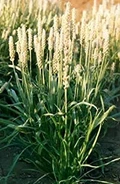
Eclipta alba is commonly known as false daisy, karisilakanni, bhringraj, etc. It is an herbaceous plant belonging to the family Asteraceae and this herb is widely spread throughout India, Brazil, Thailand, and China. It is generally found in the tropical parts of the country and grows as a weed in waste places, marshy lands, hedges, and roadsides.
Bhringraj is said to be the best drug for the treatment of liver ailments such as infective hepatitis, cirrhosis, and other conditions involving hepatic enlargement. In the pharmaceutical industry, it is the most widely used plant in hepatoprotective formulations and bhringraj is also an important ingredient for Ayurvedic herbal formulations.
Soil and Climate Requirements
Bhringraj can be grown on various types of soil. These plants prefer soils with high moisture content. It is basically grown in red loam soils that are rich in organic matter. This crop is sufficiently resistant and grows well in tropical, subtropical, and temperate regions. However, a warm climate with a temperature range of 25–35 degrees Celsius is perfect for its optimum growth and yield.
Vegetative Propagation and Planting
The crop can be propagated by cuttings of 10-15 cm length, having a minimum of 5-6 nodes. Cuttings are planted in well-prepared nursery beds or polythene bags. After 4-6 weeks of planting, the roots get established and they can be transplanted into the main field at a spacing of 20 x 20 cm. Light irrigation is given to the plots after planting this crop.
Manures and Fertilizers
Application of fertilizers at the rate of 30:40:20 NPK kg/ha and organic manure such as FYM (farm yard manure) at the rate of 15 t/ha is optimum for better growth and yield in bhringraj and generally, half of the nitrogen and the full doses of phosphorus and potassium should be applied at the time of transplanting, and the remaining nitrogen should be applied in two basal doses after the first and second cuttings.
Irrigation
Irrigation should be provided twice a week for a month after transplanting so that the plants establish themselves in better condition, and later, it should be given at weekly intervals depending upon the rainfall and soil moisture content.
Weeding
The first weeding is performed 30–35 days after transplanting, and the second is performed depending on the extent of weed growth, first harvest, weeding should be done to check the weed growth in interspaces.
Pests and Diseases
No major pests have been so far reported in this crop. These crops are basically attacked by defoliating insects. The major diseases of this crop are yellowing, leaf blight, and gall formation. These diseases can be effectively controlled by spraying 0.20% mancozeb.
Harvesting and Yield
Harvesting should be done after 90 days of transplanting and should be done by cutting the above-ground portion, leaving behind 10–12 cm for the ratoon crop. Above ground parts should be cleaned, shade dried, and packed in gunny bags, and kept in a cool and dry place. Bhringraj gives an average yield of 8 t/ha fresh herbage during the 1st cropping in the months of April-July and an average of 3 t/ha from the ratoon crop in the months of August-September. The right time to collect seeds is when the seeds turn black in color. Harvested seeds must be cleaned and stored after proper drying.











